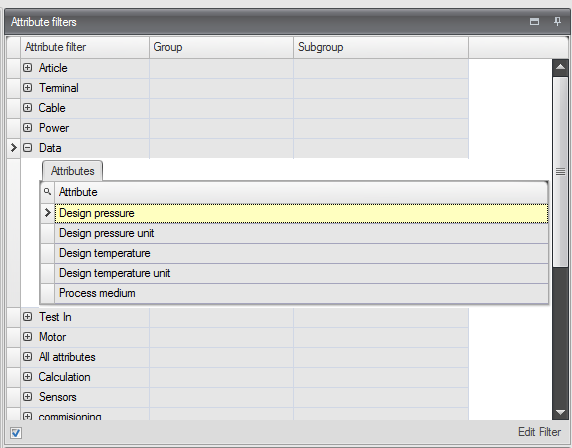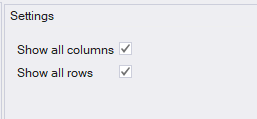![]()
Module visibility when using an I/O link
An important part of working with projects is managing data. The engineering window is very useful to quickly access and edit project data.

The engineering window is divided into several tabs. This enables the user to edit data on several levels or disciplines.
The data can be filtered using attribute filters which are made in the library or by using the "Auto Filter Row" or "Edit Filter" functionality. The data can be edited directly in the data fields or can be imported using an Excel file. Importing data using an Excel file is very useful, because all changed data is visualized with colors, see picture below. By pressing the data is imported into Typical Manager.

Notes:
1. On the I/O module tab it is also possible to edit and import/export the I/O symbolic and text and the address if the I/O module is assigned..
2. Importing can be done by structure id, reference id or tag id. If more than 1 of these three columns are present in the file that is being imported, all of them must match.
See also:
Each cell in the engineering window has a color. Each color has a different meaning:

A grey cell: Value is part of the key columns or the attribute is found in the module but is not editable (e.g. Take over Tag attribute or Target attribute).

A white cell: Attribute is found in the module or product, and can be edited (e.g. text attribute)

A blue cell: Attribute is a key attribute in a value set.
![]()
A green/grey cell: Attribute not found in the module or product. Cell has no value and is not editable.
Notes:
1. Cell colors may differ due to screen settings like contrast and brightness.
See also:
Products, modules or templates displayed in any tab page are filtered by an attribute filter. These attribute filters are managed in the library. Based on the attributes in the selected filter, the products, modules or templates in the grid are filtered. A product, module or template is shown in the grid if it has at least one corresponding attribute with the selected attribute filter.
In detail window 'Attribute filters' you can select a filter. All attribute filters created in the library are available, but only the attribute filters applicable for the selected tab page will be visible.
The detail window also shows the attribute filter group and subgroup. When moving your mouse on an attribute filter the description will be shown in a tool tip.

When an attribute filter is selected, Typical Manager will filter all products, modules or templates (based on the selected tab page) to display. Products, modules or templates which are displayed in the grid will always have some pre determined columns, the key columns. These columns are used to make a product, module or template unique. Beside the key columns, a column is added for each attribute in the selected filter. These columns will have the same order as the attributes in the selected attribute filter. The order of attributes in a filter can be changed in the library.
Tip! The number of attributes in this view can easily get very large to increase productivity the corresponding column is selected and made visible to the user when an attribute in an attribute filter is selected.

The key columns (red) are columns which are used for importing data into the right module. The attribute filter columns (green) are columns which are shown based on the selected attribute filter.
It is also possible to bypass the attribute filters by selecting the ´Show all columns´ or ´Show all rows´ checkboxes in the settings detail panel.

When the show all columns checkbox is checked, all of the available attributes in the company standard will be visible in the engineering view.
When the show all rows checkbox is checked, every module or product will be shown, even if there are no matching attributes for it.
By using these settings it is possible to check why a module is not in a filter, see all attributes of the filtered modules or see/export all data for all modules.
Notes:
1. The "Variant" and "Options" columns are only visible in the following tabs:
- Products;
- IO modules
- Document modules;
- Logical modules;
- Scada modules;
- Electrical modules.
The functionality of these two columns is only to display more information. These columns are not used for import.
See also:
In the library it is possible to link I/O to electrical, logical, scada and document modules. In the engineering window, only modules which are enabled in the current project will show up. If a module is linked to an I/O module, then the linked I/O should also be enabled to let the module appear. If the module or the linked I/O module is not enabled, the module won't appear.